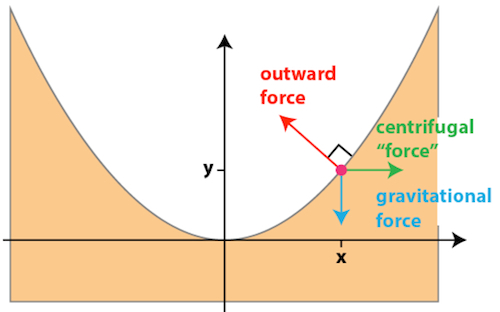

Near a massive object, the shortest distance is curved in three-dimensional space. Far from any gravity source, the shortest distance is a straight line in three-dimensional space. On a flat map theplane's flight path looks curved, but on a globe, that path is the shortest one!Light travels along a geodesic path between two points in spacetime. If you have ever taken a long flight, you probablyalready know that the shortest distance between two cities is not a straight line.Non-stop flights from the United States to Europe fly over parts of Greenland.

The Earth is simply following the shortest path in four-dimensional spacetime. The Earth does not orbit the Sun because the Sun is pulling on it. Einstein proposedin his General Relativity theory that what is called gravity is reallythe result of curved spacetime. Light travels along the shortest path between two points in spacetime (a geodesic).If the geodesic is curved, then the path of light is curved. But if the beamof light curves in the accelerating elevator, then the equivalence principle says that the beam of light should also follow a curved path in a gravitational field. If the elevator is accelerating upward, then the beam will follow a curved path downward relative to you. The person outside still sees the beam travelling in a horizontal direction. If your elevator is moving at a constant velocity upward relative to the person outside, you will see the beam of light travel in a straight-line path angled downward. If your elevator is at rest, then you will seethe beam of light travel in a straight horizontal line. Now suppose someone ``at rest'' outside your elevator way out in space shines a flashlight horizontally across the elevator you occupy toward thefar wall of the elevator. No experiment would help you distinguish between being weightless far out in space and being in free-fall in a gravitational field.

A consequence of this is that if an elevator is falling freely toward the ground because of gravity, an occupant inside will feel weightless just as if the elevator was far away from any planet, moon, or star. It states that ``there is no experiment a person could conduct in a small volume of space that would distinguish between agravitational field and an equivalent uniform acceleration''. The two elevator experiments get the same result!Įinstein used this to formulate the equivalence principle that would be the foundation of GeneralRelativity. A ball released in the upward accelerating elevator far out in space will also accelerate toward the floor at 9.8 meters/second 2. (Modern readers can substitute ``rocket ship'' for Einstein's elevator.) If a ball is dropped in the elevator at rest on the Earth, it will accelerate toward the floor with an acceleration of 9.8 meters/second 2. He proposed an experiment involving two elevators: one at rest on the ground on the Earth and another, far out in space away from any planet, moon, or star, accelerating upward with an acceleration equal to that of one Earth gravity (9.8 meters/second 2). Part of Einstein's genius was his ability to look at ordinary things from a whole new perspective and logically follow through on the consequence of the insights he gained from his new perspective. The fact that the twomasses are the same is why Galileo found that all things will fall with the sameacceleration. In Newton's second law of motion,an object's mass is measured by seeing how much it resists a change in motion (its inertia).In Newton's law of gravity, anobject's mass is determined by measuring how much gravity force it feels. Einstein was intrigued by the fact that the two ways ofmeasuring mass come up with the same value. Einstein's Relativity Curved Spacetime Chapter index in this window Chapterindex in separate window This material (including images) is copyrighted!.See my copyright notice for fair use practices.Įinstein extended his Special Relativity theory to include gravitation andnon-uniform motion.


 0 kommentar(er)
0 kommentar(er)
